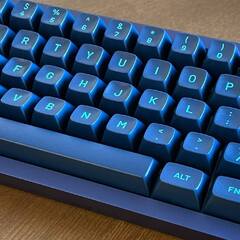-
Posts
2,325 -
Joined
-
Last visited
Awards
This user doesn't have any awards
Profile Information
-
Gender
Male
-
Location
U.S.
-
Member title
Forum Lurker
System
-
CPU
i5 13600k
-
Motherboard
AsRock z690 PG ITX
-
RAM
32gb @ 5600
-
GPU
Radeon 5700
-
Case
Cooler Master NR200
-
Storage
1tb nvme KC3000; 2tb nvme for game storage
-
PSU
Cooler Master V850 sfx
-
Display(s)
LG 2k 144hz IPS 27" panel
-
Cooling
Noctua u12a
-
Keyboard
Keychron Q3 w/ lilac tactile; GMMK Pro w/ kailh box pink
-
Mouse
Razer Orochi v2
-
Operating System
Windows 11
Recent Profile Visitors
DarkEnergy's Achievements
-
Keychron K2
-

12900k vs. 13700k Temperature
DarkEnergy replied to vincent.destazio's topic in New Builds and Planning
If it helps any, I have the 13600k in an itx build with a noctua u12a cooler and topped out at 82c for core temp and 88c on package temp after 10 minutes of cinebench R23. It's not underclocked at all and did consume about 180w under the load. This was in the nr200p case (mesh) which is one of the better cases for air cooling. -

DDR5 ram speed and latency - opinions?
DarkEnergy replied to DarkEnergy's topic in CPUs, Motherboards, and Memory
Ended up getting the Team 5600 kit. It was cheap and there's no guarantee I can go past the 6400MHz max mobo supported speed. If I can get this to 6000 it would be more than worth it. -

DDR5 ram speed and latency - opinions?
DarkEnergy replied to DarkEnergy's topic in CPUs, Motherboards, and Memory
Currently on mobile but it's the ASRock z690 phantom itx -
I'm finally upgrading my computer from an FX 8350 to an i5 13600k. I'm trying to get a decent 32gb DDR5 ram kit for under $190 and can't decide if the ~$60 difference from 5600MHz CL36 to 6000MHz CL30 is worth it. From what I've read, CL timing might not matter much for DDR5 which tells me the 400MHz difference isn't worth the price increase but I'm not sure. I'm comparing this kit for $130 https://www.amazon.com/dp/B09YTTCQKT/ref=twister_B09PDMQTND?_encoding=UTF8&psc=1 To this one for $190 https://www.amazon.com/G-Skill-RipJaws-288-Pin-CL30-40-40-96-F5-6000J3040F16GA2-RS5K/dp/B09Y16CDLG The motherboard (haven't gotten yet, waiting to see if price drops) supports up to 6400MHz. I plan on keeping the computer for at least 10 years, next time I'll upgrade DDR7 will probably exist. I play at 1440p on a 144Hz monitor and GPU will be the bottleneck for quite a while (Radeon 5700).
-

Show off your old and retro computer parts
DarkEnergy replied to TheTechnerd's topic in General Discussion
Just picked up this unicorn power mac g4 for cheap. It's got 1gb of total ram, at two different speeds and three different capacities because why not. It also has some sort of aftermarket "owc" CPU upgrade making this have a 1 GHz G4 processor instead of the normal 400MHz-ish it should have. It's quite unique and a ton of fun since the previous owner had separate drives with Mac OS 9.2.2 and 10.3. It's also a bit quirky; the boot chime only functions when Mac os 9.2.2 is selected as the boot drive. When 10.3 is selected the monitor looses signal until it starts logging in about 50 seconds later which then the desktop appears. I can't figure that one out along with why the CD drive opens by itself during the boot process of both OS 9.2.2 and 10.3??? It also looks to have an 8 pin mini DIN port instead of a phone jack? -

Charging solution for old calculator, can it work?
DarkEnergy replied to DarkEnergy's topic in Hobby Electronics
I think I found the 1-trick pony I need for this to work as cheaply and simply as possible. This board combines the basic TP4056 and dc step-up converter with a more compact potentiometer. I don't need load sharing features as there will never be a load connected while the battery is charging due to how I have to charge the battery. The battery will never be used and charged at the same time. I'm also going with this 1200mAh Adafruit battery (with protection) because it's a higher capacity, thinner, still fits with plenty of room, and by default the TP4056 board is set up with a 1.2k Rprog resistor which is a current setting meant for a 1000mAh battery. With an 850mAh battery I'd have to use a different resistor to prevent damage, and with a 1200mAh battery it will just charge a bit slower which is fine and probably for the best. -

Charging solution for old calculator, can it work?
DarkEnergy replied to DarkEnergy's topic in Hobby Electronics
Yeah, I was wondering where the dc-dc converter would go in the original charging board you listed. I was looking at this board (below) that looks like the same idea as the one you just listed but it's all on one board. ebay link. Or would that still not be considered a smart type board? I've got some 10uF 25V caps around somewhere. The calculator wouldn't be connected when charging though so it should be a non-issue. I don't want to mess with the pins at the moment, maybe a future project. Thanks for the reply. -

Charging solution for old calculator, can it work?
DarkEnergy replied to DarkEnergy's topic in Hobby Electronics
The lithium battery with a step-up regulator is an interesting idea, It would certainly be the cheaper option. Since I'd need to remove the battery pack half of the calculator to charge it anyway (since there's nothing to depress the metal spring in the original charging port), I might use double sided tape to stick the flat lithium battery to the bottom and stick the step up converter on top of the battery as there should be room. Is there a way to set it up to only need to plug the usb in to charge while leaving the rest wired up or would I need to get some jst connectors and when the battery needs charging, unplug it from the step up converter and plug it into the charger module and visa versa. I've never done circuit design. -

Charging solution for old calculator, can it work?
DarkEnergy replied to DarkEnergy's topic in Hobby Electronics
I'd replace them first. They've leaked and one of the bridges connecting two of them broke due to corrosion. -

Charging solution for old calculator, can it work?
DarkEnergy replied to DarkEnergy's topic in Hobby Electronics
I guess I'm trying to figure out if I can just use this type of charger for charging the batteries since the battery compartment can be detached and charged separately. There's only a single diode in the compartment which I'm trying to figure out if it was used as some sort of half wave rectifier (thus used the AC) or if I can use DC directly (from the amazon link charger) and not worry about the purpose of the diode. It's a charger for batteries so I'm assuming it would know when the batteries are full. My guess when looking at the design is that the diode is to prevent current from flowing from the battery to charger like when the adapter is plugged into the calculator but not plugged into a wall. Added a couple pictures to show how it's set up. Calculator can be used without battery compartment. The two pins I circled are for hooking up an adapter only, they don't connect to the calculator. The two plastic plugs on the bottom are the ones that connect to the calculator. -

Charging solution for old calculator, can it work?
DarkEnergy replied to DarkEnergy's topic in Hobby Electronics
It's a commodore minuteman 1. It does work, I rigged some batteries together and hooked it up. There's not much information about it online though and the PCB is sandwiched together with about ~10-15 pins so not easy to look at the components. -
I acquired an old calculator that's unfortunately without a power supply. There's also no way I'll ever find a power supply for it. It's able to run off the wall and battery power which is through 6xAA 1.2V NiCD batteries soldered together creating 7.2V, aka not the easy pop out kind and they're long past their expiration. The original power supply outputs two voltages, 7.2V 225mA DC and 7.0V 45mA AC. The AC output is very confusing and doesn't make sense to me considering the batteries which the calculator can run off of supply DC, why not just output DC only? It plugs into a 3 pin port. My best guess is that it powers the calculator at the same time it's charging the batteries. My main question is if it makes more sense that the 7.2V DC is for charging the batteries and the 7.0V AC is for powering the calculator (assuming it converts it to DC then in the calculator?). I say this because the battery compartment can be removed and charged separately with the same plug (but using only two pins from the adapter, assuming it uses same adapter), and there's only one diode in that whole compartment, everything else is wires. I have very limited knowledge with how circuits work so I might have missed something. I'm currently thinking of getting this battery charger and hoping one of the ends has holes that line up and fit. Then I'll get those diy batteries you can solder the metal tabs together. I've attached a highly technical picture with how I think the charging works, taken from continuity tests.
-
Nipple mouse is the way to go. When I use my laptop on my lap, the trackpad is never in a comfortable position being at the bottom. As for using it, there's nothing to really "get used to." Perhaps your trackpad is larger than normal or you type funny. My wrists are on the "wrist rest" (plastic chassis) and the palms never touch the pad when typing. Windows should have palm rejection to prevent accidental touches though.






















